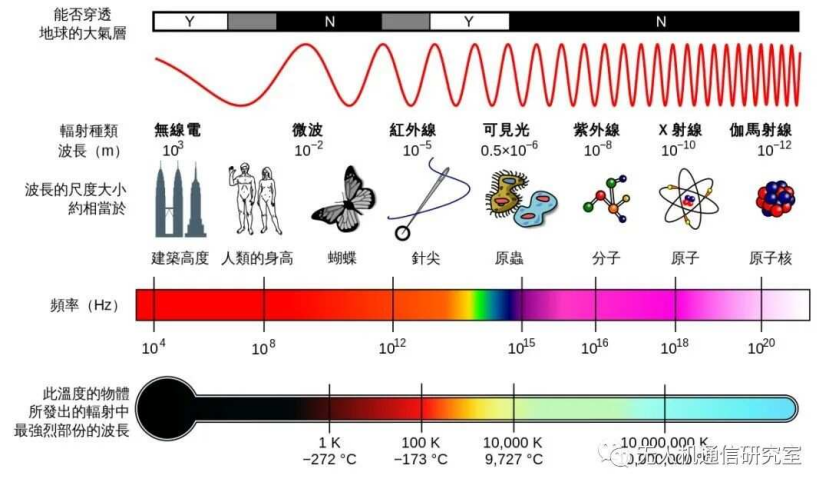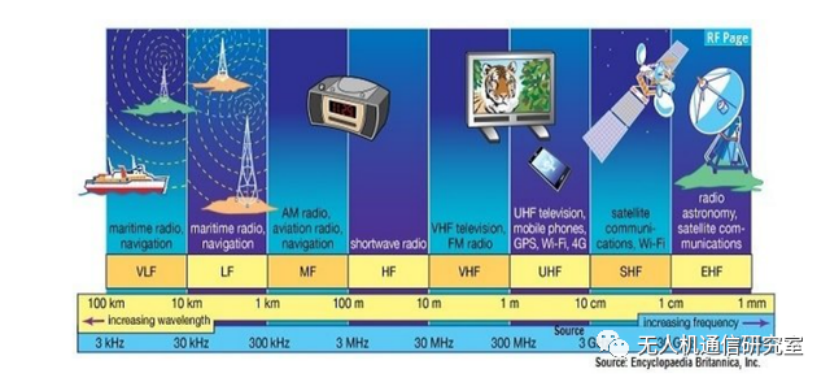Without a list of frequency bands in the real world, any discussion of antenna basic principles would be incomplete.
Why do your mobile phone and TV work simultaneously? Both use antennas to receive information from electromagnetic waves, without any conflict.
Why is there no problem?

The answer can be traced back to the fundamental secrets of the universe.
Band: Can be expressed as the total sum of frequencies within any waveform.
By using modulation, waveforms can be shifted to individual frequency bands.
(Modulating the frequency range of the waveform shifts it to the desired frequency band.)
As an example, mobile phones using the PCS (Personal Communication Service) band have their signals shifted to 1850-1900 MHz.
Broadcasting: Mainly in 54-216 MHz.
FM radio: Between 87.5-108 MHz.
All these frequency settings are called the spectrum.
The telecommunications company has spent a lot of money to obtain a portion of the spectrum. Each company bids for a portion of the spectrum to transmit information. The transmission of electromagnetic energy is regulated. When a company sells a portion of the spectrum, they can continue to transmit information in other frequency bands.
The bandwidth of a waveform is the difference between the highest and lowest frequencies within the waveform.
The energy of a waveform from 40 to 50 MHz is equal to a bandwidth of 10 MHz.
Outside the 40 to 50 MHz range, the energy of the waveform is very small.
The following table is a list of frequency bands. It also lists the wavelength corresponding to each frequency. From the table, we see that the very high frequency range is 30 - 300 MHz. (300,000 - 3,000,000 cycles per second). Therefore, if someone says they need a VHF antenna, you should now understand that this antenna sends or receives electromagnetic waves with a frequency of 30 - 300 MHz.
频带名称 | 频率范围 | 波长(米) | 应用 |
极低频(ELF) | 3-30 Hz | 10,000-100,000 km | 水下通信 |
超低频 (SLF) | 30-300 Hz | 1,000-10,000 km | 交流电源(虽然不是透射波) |
特低频 (ULF) | 300-3000 Hz | 100-1,000 km |
|
甚低频 (VLF) | 3-30 kHz | 10-100 km | 航行的灯塔 |
低频 (LF) | 30-300 kHz | 1-10 km | AM收音机 |
中频 (MF) | 300-3000 kHz | 100-1,000 m | 航空和AM收音机 |
高频 (HF) | 3-30 MHz | 10-100 m | 短波收音机 |
甚高频(VHF) | 30-300 MHz | 1-10 m | FM收音机 |
特高频 (UHF) | 300-3000 MHz | 10-100 cm | 电视,手机,GPS |
超高频 (SHF) | 3-30 GHz | 1-10 cm | 卫星链路,无线通信 |
极高频 (EHF) | 30-300 GHz | 1-10 mm | 天文学,遥感 |
可见光谱 | 400-790 THz (4*10^14-7.9*10^14) | 380-750 nm (纳米) | 人眼 |

Extremely Low Frequency (ELF)
The frequency range from 3Hz to 3KHz is known as the extremely low frequency or ELF range in the electromagnetic spectrum. This range is highly susceptible to interference and easily distorted by atmospheric changes. Due to the need for large antenna wavelengths, this is actually impossible to achieve, making it challenging to design a system in this era. Scientists use this frequency band in earthquake research to understand natural activities in the Earth's atmosphere.
Very Low Frequency (VLF)
Extremely low frequency is the starting range of radio frequency and practical radio transmission systems, ranging from 3KHz to 30KHz. However, due to the reason of the long wavelength, the design and implementation of antenna systems are extremely complex. It has already been used in submarines and is still used in time wireless radio stations that synchronize clock signals between two remote locations.
Low Frequency (LF)
The low frequency range is from 30KHz to 300KHz. One of the important characteristics of low-frequency signals is that they are reflected by the Earth's ionosphere, making them suitable for long-distance communication. Due to its long wavelength, it has low attenuation on large terrain such as mountains, so it is generally called ground wave.
Amateur radio operators use low-frequency signals; when other types of communication sources fail in certain situations (such as natural disasters), it is one of the most important sources of information transmission. Other fields include military applications, such as submarines, RFID tags in near-field communication, and some low-frequency radio broadcasts.
Medium Frequency (MF)
Since the beginning of radio transmission in the early 19th century, medium frequency has been one of the most popular frequency bands. MF operates in the range of 300KHz to 3MHz. The design of transmitters, receivers, and antennas is relatively simple compared to other high-frequency transmission frequency bands. Medium frequency has been widely used in AM radio transmission, ship and aircraft navigation systems, emergency distress signals, cost protection and other experimental applications.
High Frequency (HF)
The HF signal range is between 3 MHz and 30 MHz. This frequency band is also known as shortwave. It is also reflected by the Earth's ionosphere and is one of the frequency bands suitable for long-distance communication. The HF band is mainly used in the aviation industry, near-field communication (NFC), government systems, amateur radio operators, and weather radio stations.
Very High Frequency (VHF)
VHF is one of the most commonly used frequency bands, with a working range of 30 MHz to 300 MHz. Since several decades ago, VHF frequencies have been widely used for analog television broadcasting. FM radio broadcasting in the 88 MHz to 108 MHz range operates within the VHF band.
Air traffic controllers and airline pilots use frequencies between 118 MHz and 137 MHz for communication. Another application includes private and commercial radio stations, medical equipment (magnetic resonance imaging), amateur radio, and military applications. It is usually affected by the terrain, but is suitable for short-distance communication.
Ultra High Frequency (UHF)
UHF is the most important frequency band in modern wireless communication systems. It ranges from 300 MHz to 3 GHz and the design and implementation of the system are extremely complex. It has many sub-frequency bands, some of which are restricted and allocated only to specific applications. It is used for GPS navigation systems, satellites, pagers, Wi-Fi, Bluetooth, television broadcasting, and the most important GSM, CDMA, and LTE mobile transmission.
Ultra High Frequency (UHF)
Ultra High Frequency operates within the range of 3 GHz to 30 GHz. It can only operate in a line-of-sight path because any obstacles between the transmitter and the receiving station would interrupt communication. It is commonly used for point-to-point communication, satellite systems, Ku-band digital television broadcasting (DTH services - direct to home), Wi-Fi (5GHz channels), microwave ovens, and mobile networks. Due to the high loss of ordinary RF cables, waveguides are suitable for the transmission between the transmitter and the antenna. Due to the smaller wavelengths and complexity of the SHF band, system design is very difficult.
Extremely High Frequency (EHF)
The Extremely High Frequency band is the highest frequency band in the radio frequency spectrum, ranging from 30 GHz to 300 GHz. Due to its complex nature and line-of-sight requirements, EHF is only used in advanced communication systems. EHF is used in radio astronomy and remote sensing (weather analysis). Due to the available large bandwidth, it is recommended to use high-speed internet systems such as 5G technology for future transmission networks.
AFU TELECOM is a Wireless Telecom Solution Expert with professional supporting on our customers' business globally. AFU TELECOM is always focusing on and specializing in O-RAN, Marco Cell, Small Cell, Active DAS, Public Safety and Optics Network Solutions including Antennas, Filters/Combiners/TMAs, RF Repeaters, Optics Devices and Site Accessories, especially AFU Core Team are very professional in Wireless Telecom with rich experience on our product portfolios. The Highest Priority of AFU TELECOM is Customers' Satisfaction and Product Quality. AFU MISSION IS TO CONNECT EVERYTHING!

